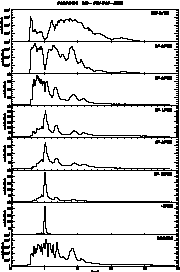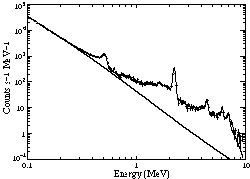Back To OSSE Solar Flare Web Page
1991 June 4 (X12+)
A GOES X12+ solar flare occurred on 1991 June 4 at an H-alpha location of N30E70 (heliographic coordinates) saturating the GOES detectors for more than 15 minutes. The soft X-ray flux began at 3:37 (13020 s) UT and lasted for more than 4 hours. At the time of flare onset, OSSE was viewing the Sun continuously with two detectors while the remaining two detectors were alternately pointing at and 4.5 degrees off the Sun at 131.1-s intervals. Significant emission to greater than 100 MeV was observed with the nuclear gamma-ray line emission lasting for more than 2 hours. High-energy neutrons were also detected.
Count rate time profiles in various energy windows at a temporal resolution of ~8 s are shown in Figure 1. All of the rates (with the exception of the >16 MeV band) exhibited saturation at the peak of emission. During these times, data from the off-pointed detector were used for analysis because the intense low-energy flux was attenuated by the collimator and shields. A representative on-axis count spectrum obtained after the peak of emission when saturation effects were minimal is shown in Figure 2. Electron bremsstrahlung and narrow nuclear line emission at 0.51, 1.6, 2.223, 4.4, 6.1 and ~7 MeV can be seen. The total fluences of these components are given in the table.
The OSSE data from this flare has been analyzed in detail and the results have been presented in a paper published in the Astrophysical Journal (Murphy, et al. 1997, ApJ, 490, 883). The main results are: (1) the nuclear reactions associated with the impulsive phase of the flare continued for at least 2 hours and resulted from ions that were probably continuously accelerated rather than impulsively accelerated and trapped; (2) the total energy in these accelerated ions exceeded the energy in >0.1 MeV electrons; (3) the accelerated alpha/proton ratio was closer to 0.5 than to 0.1; (4) there is evidence for a decrease of the accelerated heavy ion-to-proton ratio as the flare progressed (5) there is evidence for a temporal change in the composition of the flare plasma; (6) the ratio of electron bremsstrahlung to the flux in narrow gamma-ray lines decreased as the flare progressed; (7) the high-energy (>16 MeV) component of the electron spectrum was much more impulsive than the lower-energy ~MeV component; (8) a model-dependent upper limit of 2.3 X 10-5 was obtained for the photospheric 3He/H abundance ratio; and (9) energetic ions may have been present for several hours prior to and following the impulsive phase of the flare. For a PostScript version of this paper, please click HERE.
| Emission component | (photons cm-2) |
| Narrow nuclear lines >1 MeV | |
| 2.223 MeV neutron capture |
 Figure 1 |
 Figure 2 |